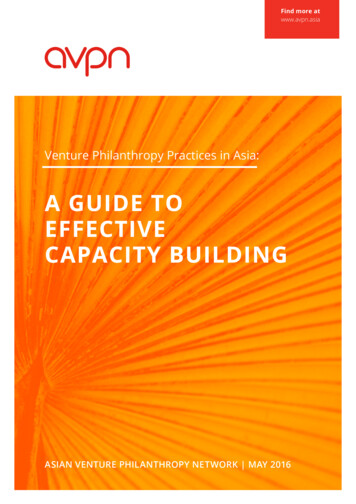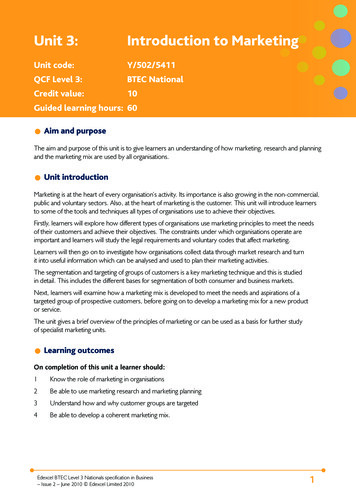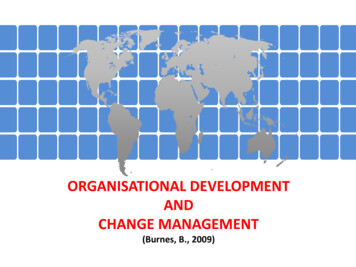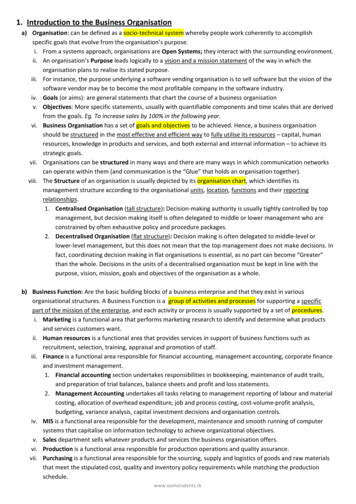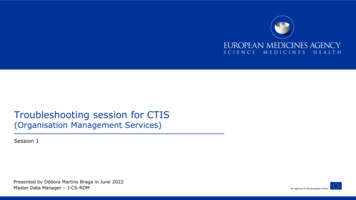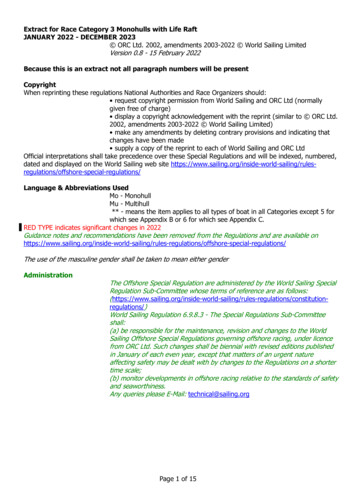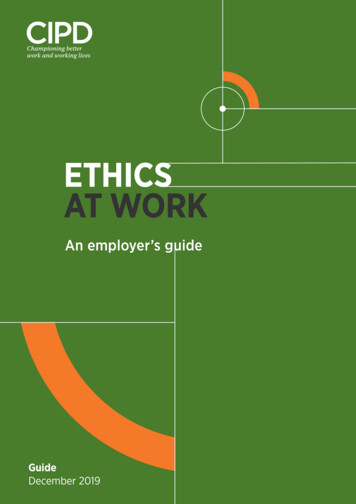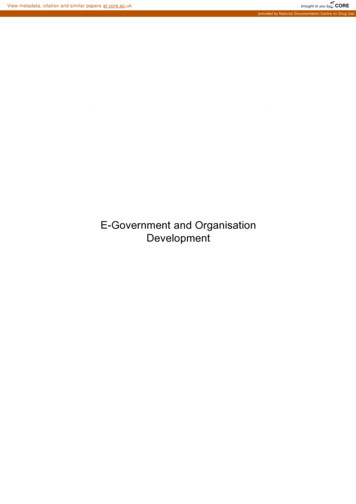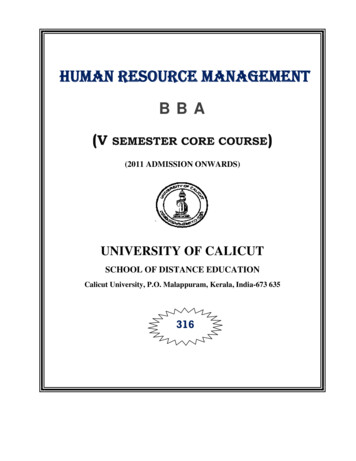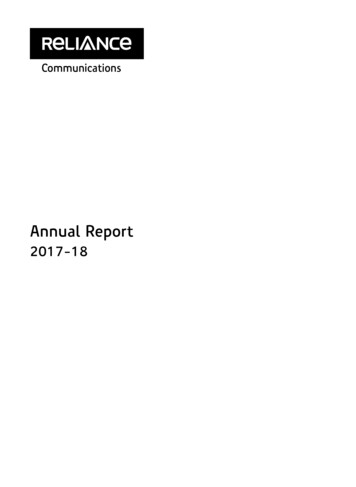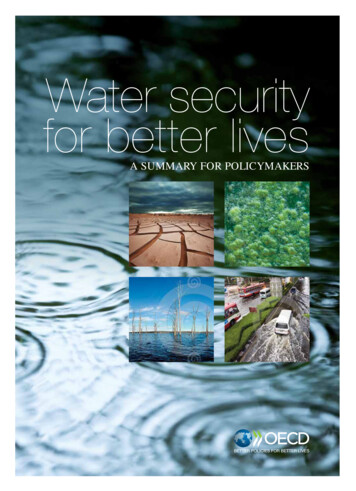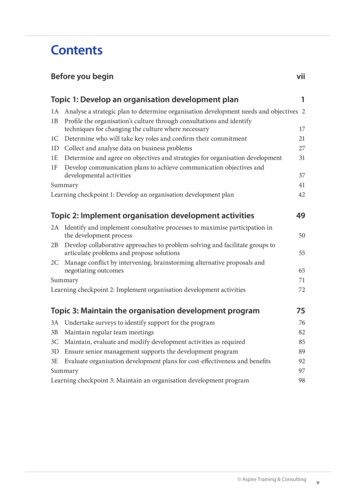
Transcription
ContentsBefore you begin viiTopic 1: Develop an organisation development plan 11A Analyse a strategic plan to determine organisation development needs and objectives 21B Profile the organisation’s culture through consultations and identifytechniques for changing the culture where necessary 171C Determine who will take key roles and confirm their commitment 211D Collect and analyse data on business problems 271E Determine and agree on objectives and strategies for organisation development 311F Develop communication plans to achieve communication objectives anddevelopmental activities 37Summary41Learning checkpoint 1: Develop an organisation development plan 42Topic 2: Implement organisation development activities 2A Identify and implement consultative processes to maximise participation inthe development process 2B Develop collaborative approaches to problem-solving and facilitate groups toarticulate problems and propose solutions 2C Manage conflict by intervening, brainstorming alternative proposals andnegotiating outcomes SummaryLearning checkpoint 2: Implement organisation development activitiesTopic 3: Maintain the organisation development program 3A Undertake surveys to identify support for the program 3B Maintain regular team meetings 3C Maintain, evaluate and modify development activities as required 3D Ensure senior management supports the development program 3E Evaluate organisation development plans for cost-effectiveness and benefits SummaryLearning checkpoint 3: Maintain an organisation development program 4950556571727576828589929798 Aspire Training & Consultingv
BSBMGT615Contribute to organisation developmentAnalyse the strategic planFor an organisation to be successful, it must set a clear vision and purpose and havestrategies in place to achieve the vision. Organisational strategic plans are developed to helpan organisation reach its desired long-term outcomes, often for a period of two to five years.Here is some information about strategic plans.What a strategic plan identifies A strategic plan identifies the organisation’s current state and thestrategies that need to be implemented to position the organisation forsuccess. It defines the vision or mission of the organisation, establishesgoals and identifies strategies to achieve these goals.The role of the strategic plan The strategic plan is developed by key stakeholders in an organisationto set the organisation’s future direction and actions to achieve success.The organisation’s structure, leadership, systems, processes, andworkforce capability and performance must be shaped by and alignedwith the strategic plan.The identification of strategic direction Changes implemented as a result of a strategic plan may includesystem and process redesign, redesign of the workforce and leadershipstructure, and changes to culture, performance or individual roles.Following the identification of the strategic direction, leaders inthe organisation can determine the operational or functional plansnecessary to meet the strategic plan’s goals and objectives.Review the plan To analyse an organisation’s strategic plan, compare the current stateof the organisation with the desired state of the organisation to identifythe areas of need that must be addressed for the strategic plan to beachieved.4 Aspire Training & Consulting
BSBMGT615Contribute to organisation developmentPrepare a development planThe development plan relates to management, leadership, people, performance, culture,skills, attitudes, capability, motivation, reward and recognition. The development plan mustensure that individuals, teams and departments transition as easily as possible from thecurrent state to the expected future state.Organisational development interventions that may be included to enable this transitioninclude the following.Knowledge managementThis is improvement to or redesign of practices and processes in the organisationthat is used to exchange and distribute knowledge. This type of intervention maybe highlighted when diagnosing risks to implementing a strategy.Process consultationThis method is used to improve processes within the organisation. Groups andteams come together to develop practical solutions to issues related to processeffectiveness and efficiency. The process is mapped and performance is reviewedto identify habits and practices that need to be improved to meet organisationalobjectives. Some examples of improvement that may be achieved are the removalof unnecessary approvals on completion of steps and putting in procedures tomanage rework so other steps are not affected.CommunicationCommunication is critical to building a positive organisational culture and achievingsuccessful relationships across the organisation. Communication must betransparent, timely and organisation-wide, for both management and employees.Team buildingTeam building helps employees get to know each other, learn to know what toexpect from each other and understand the ways they can best work together. Theactual activities depend on whether the team is new, already exists or has a newmember. Brainstorming workshops – where members develop change goals, andidentify strengths and weaknesses and ways to build on strengths and overcomeweaknesses – are popular. Team leaders, HR staff and change team members canfacilitate sessions.Intergroup developmentThis intervention involves changing the attitudes and perceptions that work groupshave of each other. A common technique is conflict resolution meetings, wheredifferent groups or teams get together to brainstorm issues affecting cooperationand efficiency, and work together to identify solutions to the issues. Common goalsshould be identified and actions undertaken to develop and achieve these goals.8 Aspire Training & Consulting
Topic 1Develop an organisation development planExample: action plan to achieve strategic goalZimbo is a national retail business specialising in electronics. It has more than 150 retail outletsacross Australia.From its mission statement, Zimbo is committed to: providing quality products and services to its customers meeting the changing needs of customers offering innovative electronic solutions delivering speedy and personalised service professionalism and enthusiasm clean and green products and services sustainable work practices continuous improvement.Zimbo is known for its enthusiastic and inclusive culture, and seeks to maintain professional andwell-supported staff.Zimbo’s vision is ‘To be a leading retailer of consumer electronics within Australia, by providingour customers with an unbeatable selection of high quality, environmentally friendly products andservices at competitively low prices’.In its strategic plan for 2016–18, Zimbo s included the following objective: Be recognised as an employer of choice that cares passionately about its staff.The Organisation Development Manager at Zimbo, Karen Wheeler, created the organisationdevelopment plan that aligns with the strategic plan. After formal consultation and feedbackgathering, she created the following action plan.Action (whatwill be done)Responsibility(by whom)Introducenew staffrewardsprogram forsuggestionsof innovativeand feasibleideasKaren WheelerTime frame(when)31 ompletiondateNew staffrewards programin place andcommunicatedto all staff Aspire Training & Consulting15
Topic 1Develop an organisation development plan1CDetermine who will take key rolesand confirm their commitmentThe analysis of the existing organisational culture and structure generally uncovers gapsand needs that must be addressed by significant changes. Who manages these changesand how they are managed will affect the successful implementation of the organisationdevelopment plan.Team members are chosen based on, for example, individual expertise, experience,knowledge and the ability to plan strategically. Their roles may relate to completing a task,managing, coordinating or administering a project to implement the strategy, findingsolutions or gathering feedback and creating plans.The following information outlines the roles of different people in organisationdevelopment.SponsorChange leaderA senior leader in the organisationis usually appointed as a sponsoror initiator of the developmentinitiative. This person drivesa positive commitmentand contribution from keystakeholders.A skilled change manager,project manager or organisationdevelopment manager is requiredto lead the implementation andoversee progress. A team ofchange agents may support thechange leader.Development championsLeadersOne or more champions can beassigned to communicate thebenefits and progress of thedevelopment plan and to sustainenthusiasm and commitment.Champions or change agentsmay be responsible for gatheringinformation and feedback todiagnose culture or workforceissues. This may involveconducting surveys, facilitatingfocus groups, conductinginterviews or making teampresentations.The leader’s role is to set thedirection and influence teamsand individuals to commit to thedevelopment plan. Leaders ensurethat development activities areimplemented and evaluated. Aspire Training & Consulting21
Topic 1Develop an organisation development plan6Generate short-term wins7Sustain acceleration8Institute changeLeaders need to plan for and track accomplishments, rewarding short-term winsthat move towards the achievement of the new vision. Consider the reward,recognition and celebration tools and techniques discussed in Topic 2.At this stage, leaders should be able to change organisational policies andprocesses that do not support the vision. This many mean hiring or promotingpeople who can implement change or create new processes.Embed the change by demonstrating the relationship between organisationalsuccess and the new behaviours.Change management resourcesThere are a variety of reliable change managementresources available on the internet to help youmanage a change: Australian Public Service Commission, ChangeManagement resources al-matters/2014/change-management Kotter International, Change management blogs,articles videos and ideos Queensland Government, ‘Change ManagementBest Practices ractice-guide.pdf Queensland Government Chief Information Office, ‘Change Management PlanWorkbook and Template’:www.nrm.wa.gov.au/media/10528/change management plan workbook andtemplate.pdf Tasmanian Archive and Heritage Office, ‘Information Management Advice 55 ChangeManagement: Preparing for change’:www.linc.tas.gov.au/ data/assets/pdf ing-for-Change.pdf Aspire Training & Consulting25
Topic 1Develop an organisation development planExample: collect and analyse business dataConducting 360 degree surveys is one way to capture how people in the organisation are behavingand performing. Findings from such surveys need to be included in the development plan, which willprovide recommended action plans to address the any organisational problems.The following is an example of a 360 degree survey conducted by individuals seeking feedback ontheir behaviour at work.Please complete the survey below and return it toby 30 June 2016.Please indicate your workrelationship with meManagerPeerEmployeeHow often do you interact withme?Very oftenSometimesRarelyOther(pleaseindicate)How would you rate me on each of the following behaviours? Pleaseprovide short examples to support your response.I display leadership to my RarelyNeverAlwaysSometimesRarelyNeverNothing needsto improveManaging stressbetterBeing morefriendly andapproachableListeningbetterBeing moreefficientUnderstandingthe businessbetterCompletingtasks on timeDelegatingtasks moreoftenExample:I motivate my team to get workdone.Example:I am effective in my work.Example:I display understanding andconsideration of others.Example:I display effective listening skills.Example:I display creativity.Example:I solve problems effectively.Example:I could improve by: (select up to three items)Other (pleaseindicate): Aspire Training & Consulting29
BSBMGT615Contribute to organisation developmentDetermine consultation and communication methodsMethods of consultation and communication will depend on the stakeholder group andtarget audience, and will determine the resources required.The following provides examples of methods of consultation for differentstakeholder groups.Manage closely Regular, personal interaction viatelephone or casual conversationto win and maintain support Consultation to seek input intochange strategy Occasional personal contact Consultation with stakeholderswho have expertise that canprovide input into the changeprocess when required Fortnightly or monthly statusupdates presented during ameeting or via email Emailed written progress orbudget reports Milestone announcements andreports Announcements and briefing viablogs/posts on wiki or intranetKeep informed Daily/regular interaction; teammember/s must be availablevia telephone, email, video or inperson for support Briefings and meetings tocommunicate change need andrequirements, and discuss options Forums to encourage participationin decision-making by seekingfeedback Workshops to train employees onnew practices or processes Morning/afternoon teas tocelebrate small wins Surveys to obtain feedback Celebratory lunches to focus onmilestone achievements34Keep satisfied Aspire Training & Consulting Newsletters emailedMonitor Newsletters emailed Announcements via blogs/postson wiki or intranet General feedback via email orwiki/intranet Organisation-wide briefings
Topic 1Develop an organisation development planCommunication planThe communication plan needs to outline actions and time lines for communicating thedevelopment plan and reporting on the implementation progress. You need to ensure thatyou include two-way communication methods, so that you can quickly and constructivelyrespond to feedback, concerns or issues.List the stakeholder groups, including end users, customers, senior management andsponsors. Identify what type of communication is critical and what organisationalapplications, such as wikis and email, are appropriate for each stakeholder group; forexample, monthly reports to senior management and sponsors but weekly emails toaffected staff.Here is some information about communication plans.Your communication plan needs to include: Who will receive information How information will be communicated How feedback will be sought, monitored and incorporated How the team will respond to feedback and ideas How issues will be recorded and monitored for continuous improvementExample: develop a communication planThe following is an example of a communication plan for communicating an objective.Development objectiveNew rewards and recognition scheme to be implemented for innovative and feasible ideas by 15March 2016Stakeholder(group)AllemployeesHow will wecommunicateinformationto them?How will we gettheir feedback?Monthly – all-staffbriefing followedby email; alsoreiterated inCEO’s message ofthe week (weekending 15 March) Listen and record feedbackduring meeting Ask employees to emailfeedback@zimbo.com.auHow will werespond tofeedback?How willwe recordand monitorissues?EmailFeedbacklog1:1 Open-door policy to allowstaff to chat 1:1 Aspire Training & Consulting39
BSBMGT615Contribute to organisation development2AIdentify and implement consultativeprocesses to maximise participationin the development processSuccessful implementation of an organisation development strategy relies on effectiveconsultation and meaningful participation and engagement of employees.Critical factors that influence successful implementation of the organisation developmentplan are presented here.Development process success factorsEffective leadership from the implementation team, ensuring they have thecapability and capacity to meet the time lines and deliverables and to help championthe changeRegularly communicating and reporting on implementation progress, including thestatus of funding, time lines, resources, engagement, issues and risksLeading the implementation of the communication plan to ensure staff are clearon the strategy, are engaged in the process and have buy-in to the outcomes andsuccessDelivering results, ensuring milestones are visible across the organisation, andacknowledging and recognising the contributions, efforts and participation of staffEngaging with stakeholders to resolve barriers and issues, including minimisingstress or performance effects and looking for alternatives or options to addresstheseWorking closely with departments to maximise engagement and looking for otheropportunities or strengths that can be leveraged to support the change50 Aspire Training & Consulting
Topic 2Implement organisation development activities2BDevelop collaborative approaches toproblem-solving and facilitate groups toarticulate problems and propose solutionsOrganisations need teams. Teams and groups arecapable of generating hundreds of ideas and solutions– many more than individuals could do ontheir own.Organisation development managers need to beskilled in bringing people together to work in teamsor groups, in order to work towards the goals statedin the organisation development plan. Teams/groupsof people need to be encouraged, even trained, towork together – this does not come naturally toeveryone. Collaborative problem-solving involvesteams of individuals working together to resolve aparticular issue or concern in the organisation.Organisation development managers often have to consider or reconcile a variety of interestsin order to address complex business problems. Some of these problems can be widespreador founded on strong cultural bases. This makes them difficult to resolve without theinvolvement of employees and stakeholders.When multiple stakeholders collaborate, they create a collective resolution that is mutuallybeneficial to all parties. This collaboration can support mobilising the resources necessaryfor more workable and sustainable solutions.Collaborative problem-solving processOne approach to getting the team to work together to solve problems is to lead them in the8-Disciplines (8D) method. The 8D method was developed by the Ford Motor Companyin the late 1980s to help teams resolve design and production issues. The method is nowapplied in a number of organisations to solve any number of problems.Once the organisation development plan has been created, you can use the eight disciplinesin the problem-solving process. It is important to ensure that each step applied in thisproblem-solving process, so thorough planning and preparation are vital. Prior toimplementing the problem-solving process, you need to identify who will be involved.Create a plan outlining your approach: who will be involved, the time frame and anyresources that are required to assist with solving the problem.An outline of each of the steps in the 8D method is provided here. Aspire Training & Consulting55
Topic 2Implement organisation development activitiesTreat risksEven when risk tolerance is high, risks need to be treated. The objective is to eliminate oravoid the risk where possible. Should the risk occur, the objective is to control the outcome.Here are the five options for managing risks.Avoid the riskOptions to avoid risk include the following: Do not become involved in activities that lead to thepossibility of the risk eventuating. Outsource risk-related tasks to contractors or specialistproviders. Discontinue practices that may realise the risk.Reduce thelikelihoodThe likelihood of risks can be lowered by removing variousstimuli or situations likely to materialise the risk. This may beas simple as: reducing exposure to the risk environment removing or reducing activities that may lead to the riskbeing triggered using inspection controls and quality assurance measures ensuring time lines are realistic.Reduce the impactContingency plans are a valuable tool for helping reduce theimpact or consequence of a risk event and include: establishing measures to control or minimise damage ifthe risk is realised, such as fraud control planning, publicrelations, disaster recovery planning, pricing controls developing administrative measures, controls, policy orprocedures to provide guidance.Share the riskIf a risk is too high to take on alone (for example, expandingthe business into a new industry), partnerships and strategicalliances allow for risks to be shared. Sharing the risk alsocommonly involves external investors such as venturecapitalists, or insurers and underwriters, and may includeinsuring against an event occurring.Retain the riskSome negative risks may be at an acceptable level when thelikelihood and consequences can be adequately managedinternally within the organisation. Others may have such alow level as to not warrant any effort. For example, occasionalstaff absences may not have a huge impact on meeting timelines, so this low-level risk can be accepted. Aspire Training & Consulting59
Topic 2Implement organisation development activities2CManage conflict by intervening, brainstormingalternative proposals and negotiating outcomesConflict may involve a simple disagreement between two or more colleagues trying to reacha decision or solution, or it could be based on international disagreement between nations.People experience conflict when their perceptions, values, ideas or beliefs are threatenedor obstructed by another person, group or party. People react to conflict as a result of whatthey believe or perceive to be true.In creating or implementing an organisation development plan, conflict may result fromdifferent opinions relating to people’s own perceptions or experiences of how things workwell or how things should be done. Conflict may also result from personality differences andtensions where people have strong emotional attachment to their ideas and opinions andmay see different views as confrontational or attacking.Here is some information about possible sources of conflict and how to manage conflict.Sources of conflictOther sources of conflict include the following: Goal incompatibility – people have goalsthat interfere with each other Differentiation – people have differingbeliefs and attitudes due to theirbackgrounds and experiences Task interdependence – team membersoften have to rely on others in completingtheir own tasks Scarce resources – competition betweenpeople arises when resources are scarceConflict managementAs an organisation development leader, youneed to play a key role in helping resolveconflict situations. The benefits of effectiveconflict management include the following: Increasing understanding of people’srelationships with one another Developing respect and respectfulbehaviours Improving your leadership credibility in theorganisation Minimising future conflict situations Ambiguity – this increases the risk ofpeople crossing over or interfering withthe goals, objectives or work of otherparties Creating a more harmonious workenvironment that fosters trust,cooperation and collaborative decisionmaking Communication issues – people lackthe opportunity, ability or motivation tocommunicate effectively with others Strengthening and reinforcingorganisational values, behaviours andpolicies Aspire Training & Consulting65
Topic 2Implement organisation development activitiesThe conflict resolution stepsThe conflict resolution steps (adapted from Trinder & Wertheim 2005) are a tool thatmanagers and team leaders can use to resolve team issues and achieve win–win solutions.This tool identifies six positive actions a manager or team leader can undertake within aconflict situation.These steps are shown in the following information.Conflict resolution steps can: contain and manage strong emotions verbally express own thoughts and feelings identify and express own interests empathise with others generate a number of solutions to the problem negotiate a win–win solution.AMG is a small technical consulting company. Conflict arose between twocolleagues on the approach to a client problem. Each person had a differentview on the most appropriate and cost-effective solution. Colin, who was toimplement the solution, believed it would be preferable to submit a solutionthat would be sustainable over a long period of time, even though it was morecostly to the client and required resolving a number of challenges. Kate, theclient manager, believed she understood the client needs best. She alsobelieved the client was looking for a less costly solution and might be quiteagreeable to an updated solution at a later stage.v1271Example: manage conflictIn helping to resolve this conflict, the area manager, Michael, asked Kate andColin to outline their ideas and articulate why they thought their solution was preferable. Michaelasked that each person only discuss the facts and not share their emotional justifications. Michaelthen summarised the situation and each person’s views, checking that this was accurate. He guidedKate and Colin on agreeing to a solution by breaking the issues into smaller parts and addressingthem according to organisational processes.Here is some information about managing conflict.Possible solutions to managing conflict Michael started with the ‘obvious’ solution (if there was one) and discussed itsadvantages, disadvantages and alternatives. He helped to facilitate a brainstorming session to identify all possible solutionsand assess each option. He then encouraged Kate and Colin to negotiate a win–win outcome. Aspire Training & Consulting69
Topic 3Maintain the organisation development programTest expected resultsAs shown by the example above, establishing measures of success is anotherway of testing our assumed or expected results. We think that particular actionswill bring about a particular result. Establishing measures and then comparingactual results with assumed results is a reality-check. If the results do not meetour expectations, we then explore what should change or what should continue.Design surveysSurvey design is complex and it is easy to obtain inaccurate or skewed results. Therefore, itis important that surveys are used in conjunction with other evaluation methods to identifysupport for the development program. These can include follow-up interviews and focusgroups.Furthermore, surveys are often used to help identify where further inquiry is needed. Forexample, after obtaining an indication of stakeholder engagement, you can conduct furtherinvestigations such as interviews or focus groups to gain more understanding of or insightinto the responses.The methods used to survey, evaluate or test our success measures are critical in informingus of the level of support for the organisation development program The following presentsguidance in survey design, which is based on Bradburn, Sudman and Wansink’s 2004 bookAsking Questions: The Definitive Guide to Questionnaire Design.Here are the different elements to take into consideration when designing surveys.QuestionsClearly identify the survey’s purpose or objective, then decide what overarchingquestions you want to ask. This will help guide your specific questions.Decide who will be surveyed and how many people to involve. Will you conduct asample survey or survey everyone? When using sample surveys, you need to becareful that your conclusions will be truly representative of the wider organisation.Who you survey and the number of people you survey will influence whether yourresponses are meaningful. Sample groups also need to be consistent, so youneed to ensure that some areas are not overrepresented. For example, if you onlyreceive 2% of responses from one area and 80% from another area, the resultswill not be truly representative and therefore not valid. It is also possible that alow response rate may, in fact, be a reflection of some dissatisfaction or lack ofengagement that needs to be addressed. Aspire Training & Consulting77
BSBMGT615Contribute to organisation development3BMaintain regular team meetingsAny successful organisation transformation requirescontribution, input and participation by the peoplewho perform the work and who can readily identifyproblems or issues. It is critical that you have a highlyeffective team of motivated and enthusiastic peopleimplementing the development plan.As an organisation development manager, you musthave commitment to your team. You need them toknow you will readily share updates or importantnew information. They must also be given theopportunity to regularly share any new events, risksor issues and to celebrate success. Information sharedat team meetings may also, on occasion, indicatethe need for interventions to ensure teams have theskills, behaviours, knowledge and time to conduct effective meetings. It is important tomonitor each meeting’s inputs and outputs to ensure the flow of information is consistentand efficient, leading to actions or results.Teams should be involved in planning their meetings and results should be pushed downto the team level so that team members can openly share the causes of issues. It is alsoimportant that you conduct regular meetings with key stakeholders and seek regularfeedback from teams in the organisation who are affected by the development planimplementation.Actions to maintain regular meetingsTo help maintain regular team meetings, consider the following actions.Maintaining regular meetingsEnsure t
A strategic plan identifies the organisation's current state and the strategies that need to be implemented to position the organisation for
